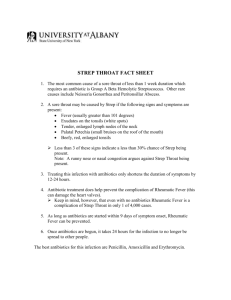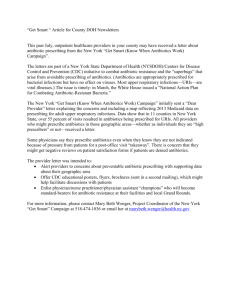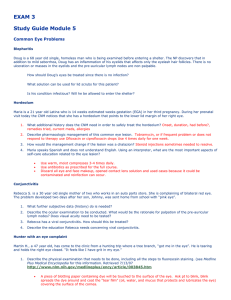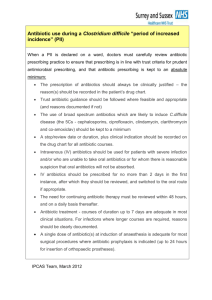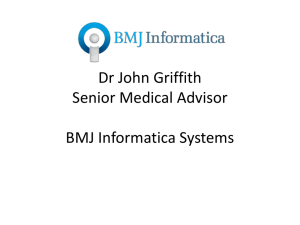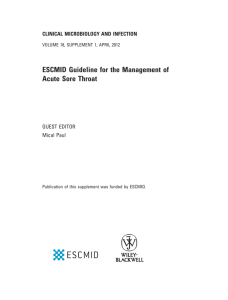childhood illness
advertisement
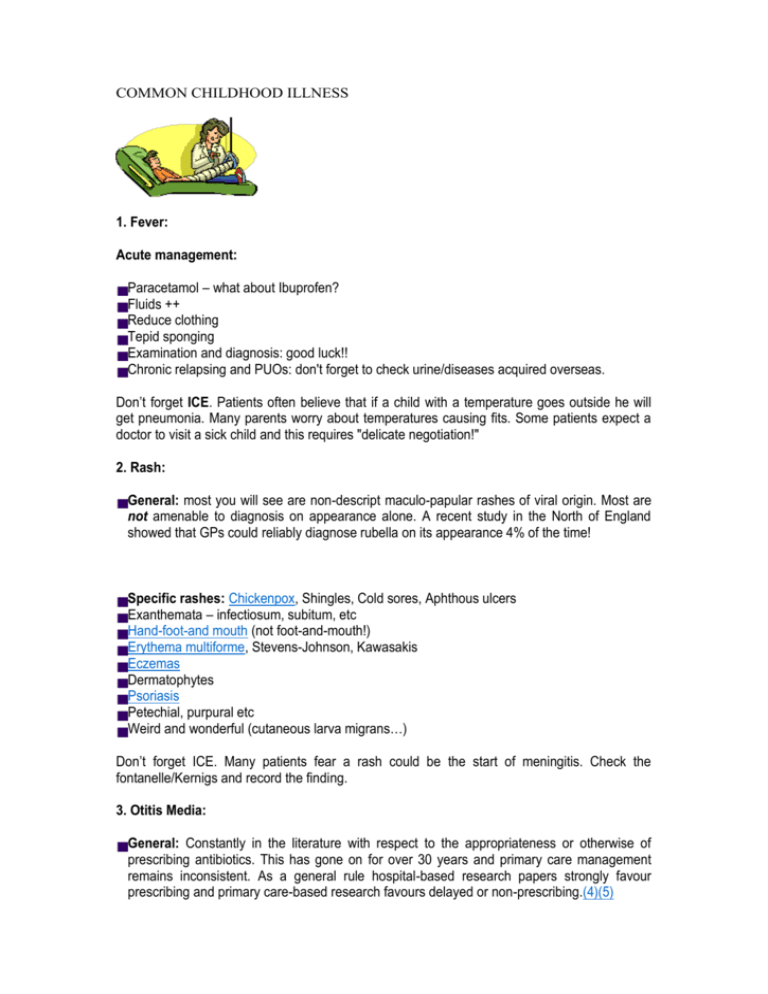
COMMON CHILDHOOD ILLNESS 1. Fever: Acute management: Paracetamol – what about Ibuprofen? Fluids ++ Reduce clothing Tepid sponging Examination and diagnosis: good luck!! Chronic relapsing and PUOs: don't forget to check urine/diseases acquired overseas. Don’t forget ICE. Patients often believe that if a child with a temperature goes outside he will get pneumonia. Many parents worry about temperatures causing fits. Some patients expect a doctor to visit a sick child and this requires "delicate negotiation!" 2. Rash: General: most you will see are non-descript maculo-papular rashes of viral origin. Most are not amenable to diagnosis on appearance alone. A recent study in the North of England showed that GPs could reliably diagnose rubella on its appearance 4% of the time! Specific rashes: Chickenpox, Shingles, Cold sores, Aphthous ulcers Exanthemata – infectiosum, subitum, etc Hand-foot-and mouth (not foot-and-mouth!) Erythema multiforme, Stevens-Johnson, Kawasakis Eczemas Dermatophytes Psoriasis Petechial, purpural etc Weird and wonderful (cutaneous larva migrans…) Don’t forget ICE. Many patients fear a rash could be the start of meningitis. Check the fontanelle/Kernigs and record the finding. 3. Otitis Media: General: Constantly in the literature with respect to the appropriateness or otherwise of prescribing antibiotics. This has gone on for over 30 years and primary care management remains inconsistent. As a general rule hospital-based research papers strongly favour prescribing and primary care-based research favours delayed or non-prescribing.(4)(5) Specifics: The most recent meta-analysis (1) shows that 80% of children are better within 48 hours of onset of symptoms regardless of management. 14% still have symptoms after 48 hours and this group shows modest benefit if prescribed antibiotics early in the course of their illness. The most favourable analysis is that at least 17 children need treatment for one child to benefit. Moreover there was a doubling of incidence of diarrhoea and vomiting in the antibiotic group. In summary, if 17 children are treated early, one may have less pain and temperature symptoms at 3-5 days, but 3 or 4 will be made more unwell because of diarrhoea, vomiting, rashes, or thrush. In addition prescribing routinely significantly increases the likelihood of recurrent presentations for the same problem. Otitis media, Secretory OM, Ear infections More recently attention has been focusing in ways of determining which children are most likely to benefit from antibiotic prescribing. Anecdotally we all have seen cases of children with recurrent OM who recover within 2-3 days if given antibiotics and who are unwell for 1-2 weeks if not. A Norwegian study (3) highlights children with 3 or more episodes of otitis media in the last 6 months as clearly benefiting from antibiotic therapy including the use of antibiotic prophylaxis over periods of minor viral illness. (These tend to be a unique subgroup of otitis media sufferers with demonstrable antibody deficiencies to streptococcal capsular antigens). (2) In General Practice we increasingly negotiate the management of OM with the patient’s parents. If they are presented the information, many are relieved that antibiotics may not be necessary. Some are insistent and then you patient management skills will be tested! Often we compromise with provision of a prescription and advice to wait 48-72 hours before filling it. (In this situation only 14% of parents redeem the prescription and their re-presentation rate for the same problem is about 50% cf. 80-85% in those given an immediate script). (5) Management: relieve pain with paracetamol or better still ibuprofen, control fever, negotiate with parents and above all, don’t be too dogmatic. Afterall, the next meta-analysis might say the opposite!! 4. Sore Throat: General: as for otitis media, despite large numbers of random controlled trials and metaanalyses, the management remains inconsistent. The consensus seems to be that antibiotics are beneficial in reducing the duration of pain and complications in proven Group A Streptococcal throat infections, if given within the first 24-48 hours. (7)(8) The consensus also is that it is difficult to diagnose Group A Streptococcal throat infections!!!!(6) It is clear that routine prescribing of antibiotics for sore throats significantly increases the likelihood of the patient re-presenting for the same condition (80% c.f. 50%), and that almost 90% of sore throats are viral in origin.(7) Specifics: The gold standard for diagnosing Streptococcal throat infection is a significant rise in titre of ASO. This is entirely impractical for management as titres are taken 14 days apart. Throat swabs are of poor sensitivity (30%) and specificity (80%) and are extremely unreliable.(6) However, the presence of pain and fever of sudden onset, dysphagia, pharyngeal or tonsillar exudate, tender anterior lymph nodes without significant coryza or cough make the diagnosis of Streptococcal sore throat considerably more likely and prescribing in this situation would be appropriate.(10) These symptoms have a 70-80% correlation with Streptococcal infection as demonstrated by rising ASO titre, but only occur in 15% of Streptococcal throat infections.(9) Urti, Tonsillectomy, Rheumatic fever, Quinsy The historical association between Group A Streptococcal throat and rheumatic fever was established in studies in 1951. Although the incidence of Gp A Strep infections has not changed at all, the incidence of rheumatic fever has dropped dramatically. This is independent of antibiotic prescribing and probably reflects a change in virulence of the organism. This does not apply for post-streptococcal glomerulonephritis where the association remains unchanged. 5. Warts and Verrucae: General: caused by same virus (HPV) but different isometric configurations to protein shell. Always benign which is worth bearing in mind when considering treatment. Treatment (11) Salicylates (67-84% clearance in 3 months). Glutaraldehyde (72% clearance in 3 months). Formaldehyde (80% clearance in 3 months). Podophyllin (92.5% clearance in 3 months). Cryotherapy (45% clearance in 12 treatments). Warts, Verrucae Remember ICE. Why do parents want their children’s warts treating? Usually it is because they believe they are very infectious (they’re not), that they won’t be allowed in school or public swimming baths (they will), or that they will need to wear (embarrassing) verruca socks (they won’t). Reassurance and explanation makes a big difference. Occasionally warts or verrucae lead to pain of significant social embarrassment. These are probably the only legitimate reasons to embark on treatment. This tutorial has been prepared by Dr P Harrop, Riversdale Surgery, March 2001 References: 1. Are antibiotics indicated as initial treatment for children with otitis media? A metaanalysis. del Mar et al BMJ 1997;314:1526-9 2. Effect of recolonisation with "interfering" alpha-streptococci on recurrence of acute and secretory otitis media in children. RPCT Roos et al BMJ 2001; 322:210-3 3. Acute Otitis Media (letter) Lindbaek et al BMJ 2000; 320:182 4. Primary care based RDBCT of amoxycillin versus placebo for acute otitis media in children aged less than 2 years Damoiseaux et al BMJ 2000; 320:350-4 5. Acute Otitis Media (clinical review) O'Neil BMJ 1999; 319:833-5 6. Evidence based case report with sore throat: diagnostic and therapeutic dilemma. (clinical review) Graham BMJ 1999; 319:173-4 7. Sore throats and antibiotics. (editorial). Del Mar BMJ 2000; 320:130-1 8. Open randomised trial of prescribing strategy in managing sore throat Little et al BMJ 1997; 314:722-6 9. Diagnosis and management of sore throat Drugs and Therapeutics Bull. 33; 2:912 10. Group A beta haemolytic streptococcal pharyngitis: current clinical concepts. Kiselica Am Fam Physn 1994; 49:1147-54 11. Tackling warts on the hands and feet - Drugs and therapeutics Bull. 1998; 36:22-4 The information contained on this site is general information which is not in any way intended to replace the specific advice that patients may obtain from their own doctor about individual care.
